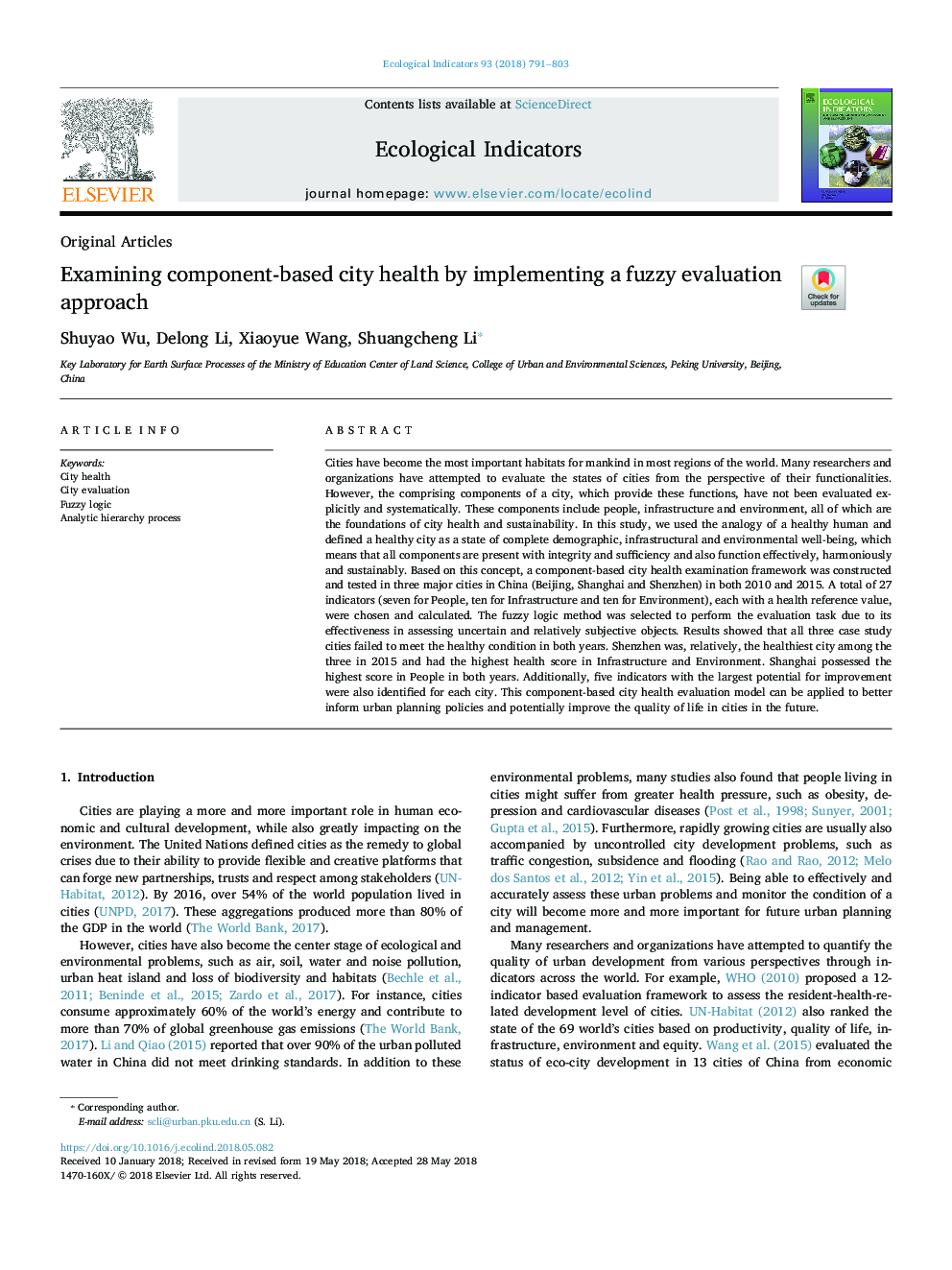| کد مقاله | کد نشریه | سال انتشار | مقاله انگلیسی | نسخه تمام متن |
|---|---|---|---|---|
| 8845223 | 1617109 | 2018 | 13 صفحه PDF | دانلود رایگان |
عنوان انگلیسی مقاله ISI
Examining component-based city health by implementing a fuzzy evaluation approach
ترجمه فارسی عنوان
بررسی سلامت شهر مبتنی بر مولفه با استفاده از رویکرد ارزیابی فازی
دانلود مقاله + سفارش ترجمه
دانلود مقاله ISI انگلیسی
رایگان برای ایرانیان
کلمات کلیدی
سلامت شهر، ارزیابی شهر، منطق فازی، روند سلسله مراتب تحلیلی،
ترجمه چکیده
شهرها مهم ترین زیستگاه برای بشر در اکثر مناطق جهان تبدیل شده اند. بسیاری از محققان و سازمان ها تلاش کرده اند تا وضعیت شهرها را از منظر قابلیت های آنها ارزیابی کنند. با این حال، اجزاء تشکیل دهنده یک شهر که این توابع را ارائه می دهند، به طور صریح و منظم ارزیابی نشده اند. این اجزای شامل افراد، زیرساخت ها و محیط زیست هستند که همه آنها پایه و اساس سلامت و پایداری شهر است. در این مطالعه، ما از تقلید یک انسان سالم استفاده کردیم و یک شهر سالم را به عنوان وضعیت کامل جمعیت شناسی، زیربنایی و محیط زیستی به دست آوردیم که به این معنی است که تمام مولفه ها با یکپارچگی و کفایت وجود دارند و همچنین به طور موثر، هماهنگ و پایدار عمل می کنند . بر اساس این مفهوم، چارچوب بررسی معیشت شهر بر مبنای جزء ساخته شده و در سال های 2010 و 2015 در سه شهر عمده چین (پکن، شانگهای و شنژن) مورد آزمایش قرار گرفت. در مجموع، 27 شاخص (هفت نفر برای مردم، ده برای زیرساخت ها و ده برای محیط زیست)، هر کدام با ارزش مرجع بهداشتی، انتخاب و محاسبه شدند. روش منطق فازی برای انجام کار ارزیابی به دلیل اثربخشی آن در ارزیابی اشیا های نامشخص و نسبتا ذهنی انتخاب شده است. نتایج نشان داد که هر سه شهر مورد مطالعه در هر دو سال نتوانسته اند شرایط سالم را بدست آورند. شنژن نسبتا سالمترین شهر در بین سه سال 2015 بود و دارای بالاترین نمره سلامت در زیرساخت و محیط زیست بود. شانگهای دارای بالاترین امتیاز در افراد در هر دو سال است. علاوه بر این، پنج شاخص با بزرگترین پتانسیل برای بهبود نیز برای هر شهر مشخص شده است. این مدل ارزیابی سلامت شهر مبتنی بر جزء می تواند به منظور اطلاع رسانی بهتر سیاست های شهری و بهبود کیفیت زندگی شهرها در آینده مورد استفاده قرار گیرد.
موضوعات مرتبط
علوم زیستی و بیوفناوری
علوم کشاورزی و بیولوژیک
بوم شناسی، تکامل، رفتار و سامانه شناسی
چکیده انگلیسی
Cities have become the most important habitats for mankind in most regions of the world. Many researchers and organizations have attempted to evaluate the states of cities from the perspective of their functionalities. However, the comprising components of a city, which provide these functions, have not been evaluated explicitly and systematically. These components include people, infrastructure and environment, all of which are the foundations of city health and sustainability. In this study, we used the analogy of a healthy human and defined a healthy city as a state of complete demographic, infrastructural and environmental well-being, which means that all components are present with integrity and sufficiency and also function effectively, harmoniously and sustainably. Based on this concept, a component-based city health examination framework was constructed and tested in three major cities in China (Beijing, Shanghai and Shenzhen) in both 2010 and 2015. A total of 27 indicators (seven for People, ten for Infrastructure and ten for Environment), each with a health reference value, were chosen and calculated. The fuzzy logic method was selected to perform the evaluation task due to its effectiveness in assessing uncertain and relatively subjective objects. Results showed that all three case study cities failed to meet the healthy condition in both years. Shenzhen was, relatively, the healthiest city among the three in 2015 and had the highest health score in Infrastructure and Environment. Shanghai possessed the highest score in People in both years. Additionally, five indicators with the largest potential for improvement were also identified for each city. This component-based city health evaluation model can be applied to better inform urban planning policies and potentially improve the quality of life in cities in the future.
ناشر
Database: Elsevier - ScienceDirect (ساینس دایرکت)
Journal: Ecological Indicators - Volume 93, October 2018, Pages 791-803
Journal: Ecological Indicators - Volume 93, October 2018, Pages 791-803
نویسندگان
Shuyao Wu, Delong Li, Xiaoyue Wang, Shuangcheng Li,
